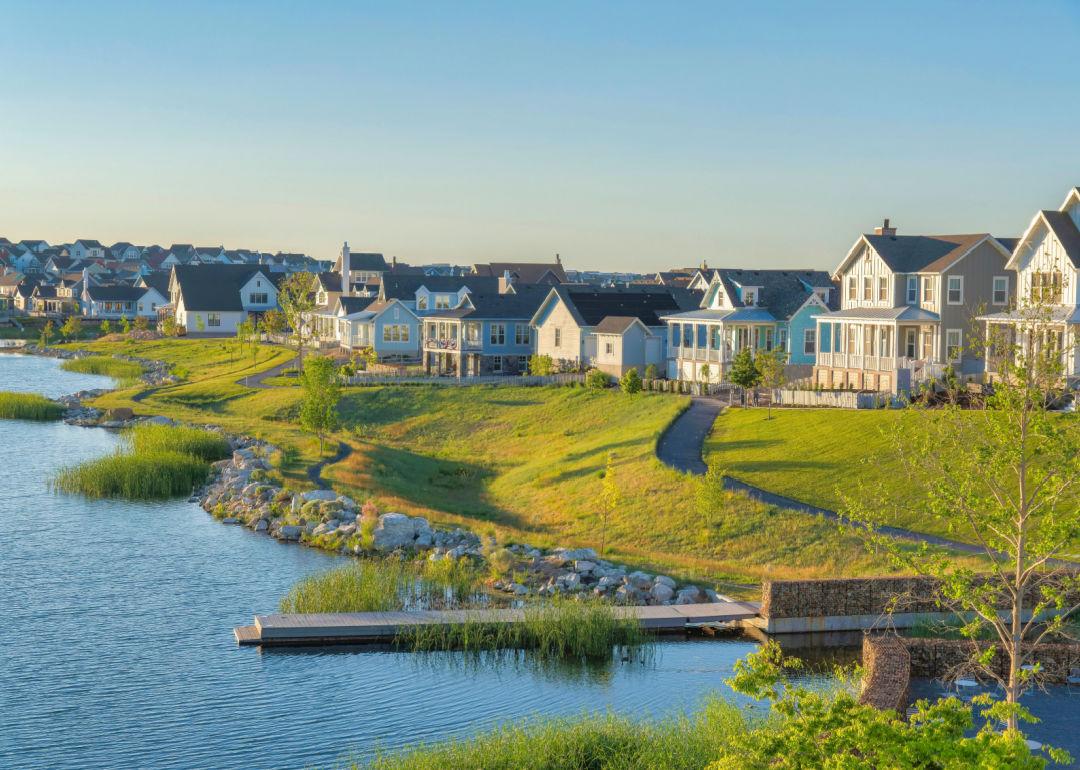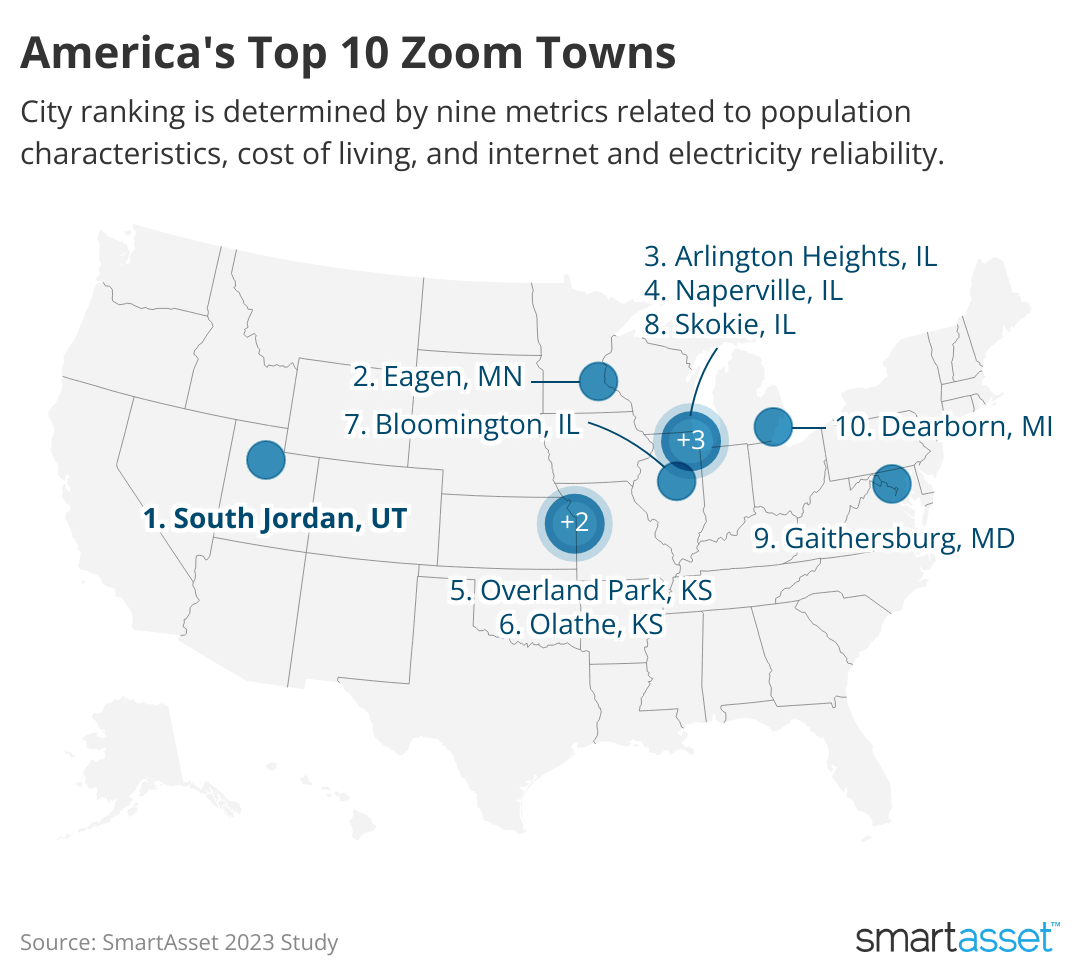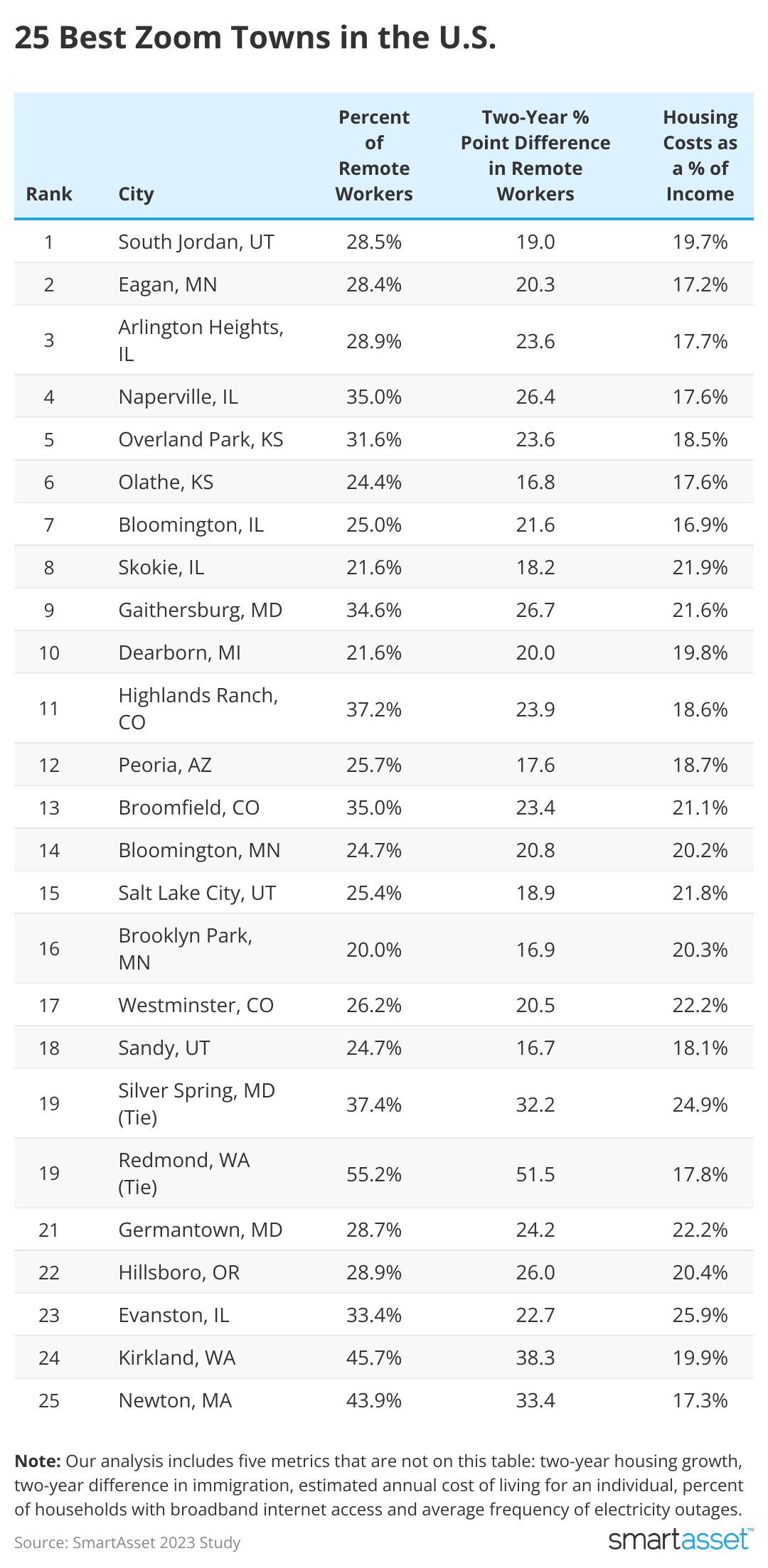
Best Zoom towns in the US
The modern worker in 2023 has more options than ever before. Forty-one percent of workers are still fully remote or in a hybrid role, which means people can opt to settle down in places that can offer a little reprieve from high living costs. This has given rise to a new moniker to describe the small to midsize towns and cities that have seen a boom in remote workers: Zoom towns.
To uncover the top Zoom towns, SmartAsset analyzed data for almost 300 cities and towns across population characteristics, cost of living, and internet and electricity reliability. These towns may offer good opportunities for remote workers looking to relocate for affordability and community.
Key Findings
- The biggest boom of remote workers happened in California and Washington suburbs. In fact, more than half of workers in Redmond, WA and Mountain View, CA operate remotely, with about 50% growth of that demographic occurring just between 2019 and 2021.
- Remote workers can expect power outages to last more than four hours in Louisiana and Virginia. Power outages last longest of all in cities in these states, and they happen more frequently than average, too.
- The midwest is home to 8 of America's top 10 Zoom towns. While South Jordan, Utah was the overall best Zoom town, the midwest offers a good balance of growth, remote work and utility reliability. In particular, the Chicago metro area makes a few appearances in the top 10.
- The cost of living in the top 10 Zoom towns is only 5% cheaper than average. While some cities – like Dothan, AL, Jackson, TN, and Lawton, OK – have a cost of living of around 20% cheaper than average, remote workers need more than just an affordable lifestyle.

Top 10 Zoom towns in the US
1. South Jordan, UT
The No. 1 Zoom town is South Jordan, Utah, a 20-minute drive from Salt Lake City. In this town of 80,000, roughly 29% of workers do so remotely – up 19 percentage points between 2019 and 2021. Over the same time period, the number of homes in the area has increased by about 22%, the third-highest. The area offers the picturesque scenery and recreational perks of the Oquirrh and Wasatch Mountains and the Great Salt Lake.
2. Eagan, MN
Eagan, Minnesota offers remote workers a quieter lifestyle with access to the Twin Cities, which are just 20 minutes away by car. Roughly 28% of the working population are remote workers – an increase from 8% between 2019 and 2021. Housing costs are affordable in Eagan compared to most other cities, making up about 17% of one's salary.
3. Arlington Heights, IL
Arlington Heights, Illinois has seen a boom in the percentage of remote workers, which increased 23.6 percentage points between 2019 and 2021. As of most recent data, roughly 29% of the Arlington Heights working population do so remotely. Housing costs in the area account for 17.69% of annual income, which is a little over 6% cheaper than nearby Chicago.
4. Naperville, IL
More than a third of the working population in Naperville do so remotely, up by 26.4 percentage points between 2019 and 2021 – the most population growth among the top 10. Housing costs in the area typically make up 17.57% of income annually making it more affordable than some major cities like the neighboring Windy City.
5. Overland Park, KS
In Overland Park, Kansas, nearly 32% of the working population are remote. Over 5,800 people aged 18 to 65 migrated to the city between 2019 and 2021, which may be a contributing factor to the 23.6% increase in remote workers over the same time period. While Overland Park is home to some major corporations like Sprint, its location also offers a 20-minute drive to Kansas City. Additionally, remote workers needing to get some fresh air will find a plethora of attractions to choose from such as the Overland Park Arboretum and Botanical Gardens, as well as the Nerman Museum of Contemporary Art.
6. Olathe, KS
Olathe, Kansas is home to Garmin International and has proven to be attractive to relocating Americans, including remote workers. Between 2019 and 2021, the 18 to 65 year old population increased by a net 3,621 people (10th-highest). In that same time period, the percent of remote workers went up by 16.8 percentage points.
7. Bloomington, IL
One in four workers in Bloomington, Illinois does so remotely, up from about 4% from 2019 to 2021. The area offers the sixth-lowest housing costs relative to annual income (16.89%) and the 29th-lowest cost of living for an individual ($28,058). Remote workers looking to fulfill the "life" part of work-life balance have access to many local attractions like the Bloomington Center for the Performing Arts, Miller Park or downtown.
8. Skokie, IL
Remote workers account for 21.6% of the working population in 2021 – up 18.2 percentage points from 2019. The city has seen the 19th-highest housing growth rate over the same time period, with a 12.05% increase in housing units.
9. Gaithersburg, MD
Over 34% of the Gaithersburg, Maryland working population are remote. Remote workers in the city don't need to worry about connectivity – roughly 95% of households have broadband internet access and if there is an outage, Gaithersburg ranks in the top fifth study-wide for the average duration of these events at 80.2 minutes. Residents looking for entertainment options can check out Gaithersburg Community Museum or various parks and recreational areas like the Great Seneca Stream Valley Trail.
10. Dearborn, MI
Though just 15 minutes by car from Detroit, Michigan, the city of Dearborn offers cheaper housing relative to its neighbor, while the number of housing units has grown by 14.17% between 2019 and 2021. Meanwhile, the number of remote workers has also grown by 20 percentage points to 21.6% of the working population.

Data and methodology
To find the top Zoom towns in the U.S. we analyzed data for cities with a population of 65,000 or more (excluding the 100 largest cities to better determine up-and-coming areas), of which 299 had available data. We looked at the most recent data available for each of the nine metrics listed below:
- Percent working from home. Data comes from the Census Bureau's 2021 1-year American Community Survey.
- Two-year point difference in remote workers. Data comes from the Census Bureau's 2019 and 2021 1-year American Community Surveys.
- Two-year net difference in immigration. Data comes from the Census Bureau's 2019 and 2021 1-year American Community Surveys.
- Housing costs as a percent of income. Data comes from the Census Bureau's 2021 1-year American Community Surveys.
- Estimated annual cost of living for an individual. This includes taxes. Data comes from the MIT Living Wage Calculator and is for 2022.
- Two-year housing growth rate. Data comes from the Census Bureau's 2019 and 2021 1-year American Community Surveys.
- Percent of households with broadband internet access. Data comes from the Census Bureau's 2021 1-year American Community Surveys.
- Average frequency of electricity outages. This is the average number of power outages occurrences lasting longer than five minutes and excluding major events in a year. Data comes from the Energy Information Administration and is for 2021.
- Average duration of electricity outages. This is the average duration in minutes of power outages for occurrences lasting longer than five minutes and excluding major events. Data comes from the Energy Information Administration and is for 2021.
This story was produced by SmartAsset and reviewed and distributed by Stacker Media.



